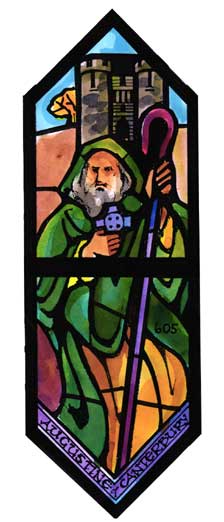|
|
|||

|
|||
Augustine of Canterbury
Window
 The crisis caused by the Germanic invasions created some of the Church’s most heroic leaders. When imperial authority collapsed, it fell to the bishops of Rome to act on behalf of the populace. In 452, it was Pope Leo who averted the attack of Attila the Hun. A hundred years later the situation had not changed, as Pope Gregory the Great organized Rome’s relief efforts and reconstruction after years of siege and neglect. Gregory was also deeply concerned about the spiritual state of the Empire, and was especially interested in re-Christianizing Britain. The man appointed to the task of evangelizing the “English” (the Germanic Angles and Saxons who had invaded Britain in the fifth century) was a monk named Augustine, from Gregory’s own monastery near Rome. As he and his band of 40 monks neared England, rumors of the fierceness of the Angles reached them, and they turned back to Rome. But Gregory sent a letter admonishing Augustine to continue on his way. So he and his monks arrived in Kent in 597, carrying a silver cross and an image of Jesus Christ. To their surprise, Ethelbert, the king of Kent received them kindly, agreed to their missionary efforts, provided lodging for them in Canterbury, and gave them access to the ancient Church of St. Martin. There they led a simple, prayerful, life, preaching to whomever would listen. Augustine and his monks met no serious opposition, and within weeks many baptisms had taken place. Conversions were so rapid it was hard for the monks to keep pace. Sometime within the next few years, Ethelbert himself was baptized and became the first Christian king in England. Augustine’s ministry to England lasted only about seven years, but by the time of his death, churches had sprung up in many parts of the kingdom, the Benedictine monastery of SS. Peter and Paul (later renamed for Augustine) had been founded, and many thousands had come to faith in Christ. The Archbishop of Canterbury is still the spiritual center of Anglicanism, and we honor Augustine as the first. He is shown standing before Canterbury’s west gate, holding a crosier (a sign of his bishopric) and the silver cross with which he first approached the King of Kent. Today the fruit of his mission is a Communion of more than 76 million members in 42 provinces around the world.
Text copyright 2004 by Anne E. Rowland. All rights
reserved. | |||
|
|||
